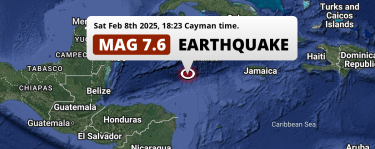Latest earthquakes near Cayman Islands today
Complete overview of the latest earthquakes near the country Cayman Islands, updated every minute. Did you feel an earthquake today in Cayman Islands? If an earthquake is happening right now near Cayman Islands, it will show up within minutes.
Recent Cayman Islands Earthquake News
These are the latest articles published related to earthquakes occurring near Cayman Islands. Check our Earthquake News section for a complete overview of articles written on earthquakes near Cayman Islands and elsewhere.
Cayman Islands Earthquake Statistics
Average
A total of 101 earthquakes with a magnitude of four or above have struck within 300 km (186 mi) of Cayman Islands in the past 10 years. This comes down to a yearly average of 10 earthquakes per year
A relatively large number of earthquakes occurred near Cayman Islands in 2020. A total of 38 earthquakes (mag 4+) were detected within 300 km of Cayman Islands that year. The strongest had a 7.7 magnitude.

Magnitude Distribution
The table below visualizes the distribution of all earthquakes that occurred within 300km of Cayman Islands in the past 10 years. No earthquakes with a magnitude of 8 or above have occurred near Cayman Islands during this time. Usually, higher magnitudes are less common than lower magnitudes. Small earthquakes with a magnitude below 4 on the Richter scale have been omitted from this overview.
| Magnitude | Earthquakes | Percentage |
|---|---|---|
| Mag. 4 | 94 | 93.07% |
| Mag. 5 | 4 | 3.96% |
| Mag. 6 | 1 | 0.99% |
| Mag. 7 | 2 | 1.98% |
| Mag. 8 | 0 | 0.0% |
| Mag. 9 | 0 | 0.0% |
| Mag. 10 | 0 | 0.0% |
Strongest earthquakes near Cayman Islands
The strongest recent earthquake of the past 10 years near Cayman Islands occurred on Jan 28, 2020 14:10 local time (America/Cayman timezone). It had a magnitude of 7.7 and struck 275 kilometers (171 mi) east of George Town, at a depth of 15 km. Discover more strong earthquakes near Cayman Islands in the list below.
In the table below you will find the strongest earthquakes that occurred near Cayman Islands in the past 10 years. You can use the tabs to find the heaviest historic earthquakes since the year 1900 or within a specific year or distance from Cayman Islands.
Earthquakes by region of Cayman Islands
Click the links below for earthquake reports for regions in Cayman Islands.
Frequently Asked Questions
These questions are commonly asked in relation to earthquakes occurring near Cayman Islands.
When was the last earthquake in Cayman Islands?
A 4.1 magnitude earthquake hit near Cayman Islands on the morning of November 24, 2025 at 11:30 local time (America/Cayman). The center of this earthquake was located 164km south-east of George Town at a depth of 10km under water in the Caribbean Sea. Check the list on our website for any earthquakes occurring near Cayman Islands in the past hours.
What was the strongest earthquake near Cayman Islands?
A 7.7 magnitude earthquake hit near Cayman Islands on the afternoon of January 28, 2020 at 14:10 local time (America/Cayman). The center of this earthquake was located 275km east of George Town at a depth of 15km under water in the Caribbean Sea. This is the strongest earthquake that occurred near Cayman Islands since the year 1900.
How often do earthquakes occur near Cayman Islands?
In the past 10 years, 101 earthquakes with a magnitude of four or higher occurred within a 300 kilometer range from Cayman Islands. This averages to 10 earthquakes yearly, or one earthquake every 36 days.

 Feb 8, 2025 06:23PM
On Saturday Evening an Unusually powerful M7.6 Earthquake struck in the Caribbean Sea 209km from George Town (Cayman Islands).
Feb 8, 2025 06:23PM
On Saturday Evening an Unusually powerful M7.6 Earthquake struck in the Caribbean Sea 209km from George Town (Cayman Islands).
